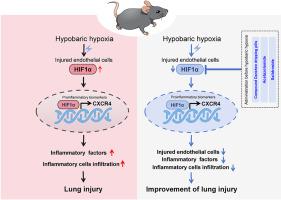CDDP、乙酰唑胺和红景天苷对急性高原缺氧早期肺损伤中HIF1α/CXCR4的调节作用
IF 4.7
3区 医学
Q1 PHARMACOLOGY & PHARMACY
引用次数: 0
摘要
背景:肺血管内皮细胞的炎症反应在低压缺氧诱导的急性肺损伤的发病机制中起着关键作用。阐明潜在的机制和潜在的治疗干预措施对医疗专业人员和暴露于高海拔地区的个人都至关重要。方法:采用等高海拔6000米低气压缺氧8、72小时的方法,建立小鼠急性肺损伤模型。组织病理学和免疫组织化学分析采用苏木精-伊红染色和免疫组织化学评估炎症。采用Western blotting检测内皮一氧化氮合酶(eNOS)磷酸化水平评价内皮损伤。采用高通量RNA测序鉴定早期炎症调节因子,western blotting检测缺氧诱导因子-1 (HIF1α)、CXC趋化因子受体4 (CXCR4)和磷酸化内皮型一氧化氮合酶(p-eNOS)蛋白表达。此外,通过实时聚合酶链式反应(real-time Polymerase Chain Reaction)测定CXCR4和所选细胞因子的表达水平。结果:低氧暴露8小时后肺组织出现明显的炎症浸润和肺损伤,24小时达到高峰。HIF1α表达在8小时显著上调,之后逐渐降低。作为HIF1α的靶基因,CXCR4也表现出类似的表达模式。复方丹参滴丸、乙酰唑胺和红景天苷预防治疗与低氧缺氧8小时后的自然反应相比,加速了HIF1α和CXCR4表达的抑制。此外,这些药物对内皮功能障碍和炎症的保护作用增强。结论:这些发现提示内皮细胞HIF1α/CXCR4轴在低氧缺氧引起的急性肺损伤的早期阶段起关键作用。复方丹参滴丸、乙酰唑胺和红景天苷下调HIF1α/CXCR4,为治疗急性高原缺氧肺损伤提供了有希望的治疗策略。本文章由计算机程序翻译,如有差异,请以英文原文为准。

Modulation of HIF1α/CXCR4 by CDDP, acetazolamide, and salidroside in early lung injury caused by acute high-altitude hypoxia
Background
The inflammatory response of pulmonary vascular endothelial cells is critical in the pathogenesis of hypobaric hypoxia-induced acute lung injury. Elucidation of the underlying mechanisms and potential therapeutic interventions is crucial for both medical professionals and individuals exposed to high altitudes.
Methods
A murine model of acute lung injury was established by subjecting mice to hypobaric hypoxia at an altitude equivalent to 6000 m for 8 and 72 h. Histopathological and immunohistochemical analyses were performed using hematoxylin-eosin staining and immunohistochemistry to assess inflammation. Western blotting for Endothelial Nitric Oxide Synthase (eNOS) phosphorylation was used to evaluate endothelial injury. High-throughput RNA sequencing was employed to identify early inflammatory regulators, and the protein expression of Hypoxia inducible factor-1 (HIF1α), C-X-C chemokine receptor 4 (CXCR4) and Phospho-Endothelial Nitric Oxide Synthase (p-eNOS) was examined via western blotting. Additionally, the expression level of CXCR4 and selected cytokines were quantified by real-time Polymerase Chain Reaction.
Results
Lung tissues demonstrated marked inflammatory infiltration and lung injury after 8 h of hypobaric hypoxia exposure, peaking at 24 h. HIF1α expression was significantly upregulated at 8 h and gradually decreased thereafter. CXCR4, identified as a target gene of HIF1α, exhibited a similar expression pattern. Preventive treatment with compound Danshen dripping pills, acetazolamide and salidroside accelerated the suppression of HIF1α and CXCR4 expression compared to the natural response following 8 h of hypobaric hypoxia. Furthermore, these agents demonstrated enhanced protective effects against endothelial dysfunction and inflammation.
Conclusions
These findings indicate that the endothelial HIF1α/CXCR4 axis plays a pivotal role in the early phase of hypobaric hypoxia-induced acute lung injury. The downregulation of HIF1α/CXCR4 by compound Danshen dripping pills, acetazolamide and salidroside suggests promising therapeutic strategies for managing acute high-altitude hypoxic lung injury.
求助全文
通过发布文献求助,成功后即可免费获取论文全文。
去求助
来源期刊
CiteScore
9.00
自引率
0.00%
发文量
572
审稿时长
34 days
期刊介绍:
The European Journal of Pharmacology publishes research papers covering all aspects of experimental pharmacology with focus on the mechanism of action of structurally identified compounds affecting biological systems.
The scope includes:
Behavioural pharmacology
Neuropharmacology and analgesia
Cardiovascular pharmacology
Pulmonary, gastrointestinal and urogenital pharmacology
Endocrine pharmacology
Immunopharmacology and inflammation
Molecular and cellular pharmacology
Regenerative pharmacology
Biologicals and biotherapeutics
Translational pharmacology
Nutriceutical pharmacology.

 求助内容:
求助内容: 应助结果提醒方式:
应助结果提醒方式:


